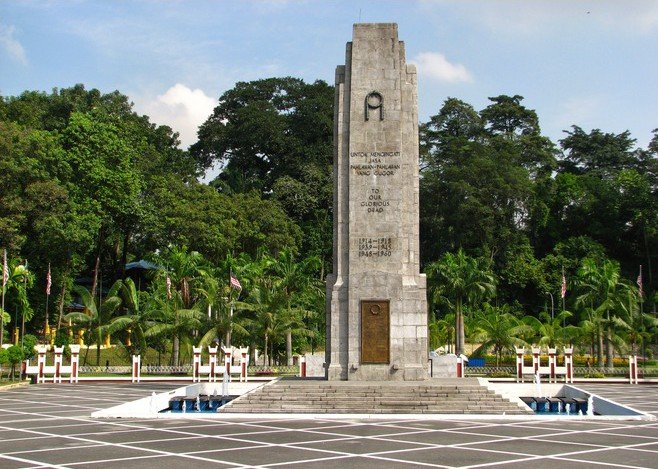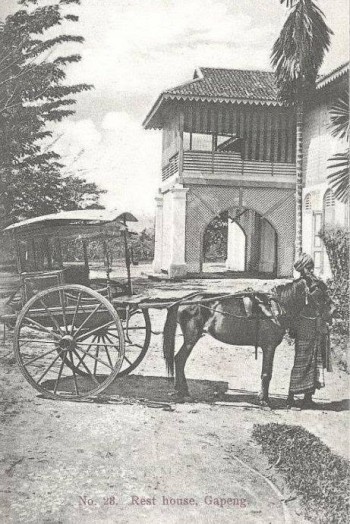
 Merdeka means Independence in the Malay language. In 1957, after many detailed negotiations and reflecting truly the unmatched [with the current insular minded] maturity of the Malayan leaders,in which there were Sikhs as well, representing beyond their real numbers, the word Merdeka was shouted three times at the strike of midnight on 31 of August 1757 from the main square, known as Merdeka Square today, in the capital Kuala Lumpur. The Prime Minsiter, Tuanku Abdul Rahman led the nation to Merdeka-Independence.
Merdeka means Independence in the Malay language. In 1957, after many detailed negotiations and reflecting truly the unmatched [with the current insular minded] maturity of the Malayan leaders,in which there were Sikhs as well, representing beyond their real numbers, the word Merdeka was shouted three times at the strike of midnight on 31 of August 1757 from the main square, known as Merdeka Square today, in the capital Kuala Lumpur. The Prime Minsiter, Tuanku Abdul Rahman led the nation to Merdeka-Independence.
Sadly, slowly but surely, all the major historical roles of the Chinese and Indian Malaysians, has been erased and played down since 1957, in the false spirit of One Malaysi. Where the ONE Malaysia concepts is always leaning upon the needs, wants and bickering of one single community that has been spoon-fed with taxes of largely the ethnic Chinese and Indian communities.
 Among the Indians, such discriminatory policies of the administration in favor of one race has also affected the Sikhs. The Sikhs have played a major role in the policing and defence of Malaya, and no lesser in the development and building the social fabric of Malaysian society.
Among the Indians, such discriminatory policies of the administration in favor of one race has also affected the Sikhs. The Sikhs have played a major role in the policing and defence of Malaya, and no lesser in the development and building the social fabric of Malaysian society.
The Sikhs role has been largely forgotten and washed off the history books. Thus it has become important the old history of Sikhs is preserved and recorded. Many efforts made by Sr Malkiat Singh Lopon about 49 years, did bear some fruit, but not fully materialised, where a small text book is readily available to Punjabi and Sikh community and it's youngsters who can remain connected to their glorious history in this country and roles played by their ancestors. Let us go back, 150 years into history - around 1828.
By 1828, it appears Sikhs had traveled to this region. In that year according to the Lanfang Archives of the Lanfang Republic, which existed in West Kalimantan, with Sinkiawang as it's capital, was negotiating with two Sikhs, to recruit Sikh soldiers to defend their republic from the Dutch.
In 1836, Lord McCoy passed with 50 Sikhs, to work his sugar cane plantations around Woolgoolga, in Queensland, Australia.
By 1851, Sikhs of the Loodhiana regiment passed on their way to China, where they ended the second opium war.
Although officially it is believed Sikhs arrived into Malaysia first around 1873 they came as the police to guard the mines and keep law and order during the intense gang fights between the various Chinese mining clans. Long before this, by 1851, Sikhs were already in Malaysia.
A key freedom icon of Punjab, Bhai Maharaj Singh, and his disciple, Kharak Singh, were exiled by the British to Singapore in 1851. He was kept in a windowless dungeon at the Outram Road Prison, where he died six years later. A samadhi, or memorial, was built at the place of his cremation - which became a holy place for his followers. THIS action alone is very much against the core principle of Sikhs' teachings. He was believed to have saintly powers, and the locals refer to him as keramat-wala (the "Miracle Worker"). A year later, Kharak Singh was seized on the orders of Lord Elgin, taken aboard a gunboat and sent to Penang. The Samadhi of Bhai Maharaj Singh now constitutes part of the Silat Road Gurdwara in Singapore.
In 1869, 100 men were recruited from local Sikhs around Kuala Selangor to defend the fort at the mouth of the river, proves Sikhs were already present in some numbers earlier than 1869.

By 1873, in Larut -Perak burly Sikh police men, with sprinkling of Pathans and Punjabi musalmaan law men soon established the peace and earned the respect of the locals, when they were used to stop the clan fights between Chinese miners.
Over the years, larger numbers of Sikhs arrived, and soon well over 130 Gurduaras were established throughout the country, some by the Police Forces.The capital has well over 18 magnificient gurduaras, with another over 23 in the third largest Malaysian City, Ipoh, once the world's tin mining capital.Locally, Ipoh was also known as Malaysian Punjab.
The second largest city of Malaysia is Penang(GT), where within the island there are three Gurduaras and across within its Province Wellesley strip there are another two at Prai and Butterworth. One of these on the island, the diamond Jubilee Gurduara built in 1901, also has the road that it is situated along named as Gurduara Road. It is a very large moorish artitectually built building, and listed, as part of the states' heritage.It is a very large magnificient gurduara,once the centre of Sikh travel into and out of Malaya towards India, and east onwards towards Shanghai, BC, Phillipines and H'kong, and Sumatra.

Other smaller towns of Malaysia, apart from Taiping,which is blessed by two Gurduaras, generally have one large Gurduara, which becomes the hub of both social and religious activities of the Sikh communities.There is also another large Gurduara, known as Wadda Gurduara in Ipoh which has the road running past it, named as Gurduara Road.
Following Merdeka, the burden fell upon all Malaysians to take over and fill slowly at first, the jobs and positions vacated by the colonial powers' servants. Among these were many sikh Malaysians. Able Sikh youth whose forefather came as simple policemen and watchmen were soon reaping the rewards of their hard work and filtering into the leadership reins of this small nation with the education given by the parents.
Once such individual was a turbaned Fighter Pilot Officer Jaswant Singh of Kuala Lumpur.He became the first local born Sikh pilot officer. During a national parade of the Air Force, he was honored by the nation's defence secretary for his services to the country. He went on to become a senior wing Commander in independant Malayan AirForce.
Another Sikh Sardar Gurnam Singh Gill, from Seramban won an american scholarship,to study in USA.He was the secretary of Negri Sembilan Transport Union, as well as the National Transport workers Union.He went on to become the preseident o Seremban Town Council and was appointed by royal accent to be a member of Negri Sembilan State executive assembly.
The British Government offered two scholarships, known as Queens scholarships, to capable Malayan students .Two Sikhs, Sardar Satwant Singh Dhaliwal, and another Sardar Chatter Singh Data qualified, and on 1957 Vesakhi these two were honoured by the community before their departure to UK by the Penang Naujawan Sikh Association in a farewell party.
On return from their studies, these two successfully became professors and achieved high positions in the country. Professor Satwant Singh Dhaliwal was a well known name in University of Malaya. Professor Chatter Singh became a dean (I believe ) in the University of Science in Penang.
In 1955 and English Brigadier Hannikar wrote a book titled ..the "Red shadow over Malaya", in which he discuss the threat from red Chinese communism. He also writes about the forces fighting the Malayan emergency in Malaya-he writes that the Sikh, Punjabi Musalmaan, some Dogra and other northern Indians are wrongly referred to as Bengalis. Sadly this wrong reference continued even after Merdeka, and Sikhs were more commonly labelled with this wrong word, due to ignorance of the locals and the failure of Sikhs to educate about themselves.
Even when in recent years when Bangalis began coming to work in Malaysia, the local people still continued to see Sikhs generally as bengalis; and the bangladeshis as bangla or bangladeshi.
However, it was mainly after 1984, the educated class realised their folly and began to refer Sikhs more accurately as Sikhs or Punjabis.
Brigadier Hannikar continues to write that even though the Sikh population is small in number, they are over represented and seen as a force in high and influential positions.The early Sikh community in Malaya produced a string of prolific writers. In one book, Maha Jang Europe ("Great European War") 1914-1918 AD, the writer, Havildar ("Sergeant") Nand Singh, vividly described the daring exploits of the Malay States Guides in Aden when they fought the Turkish forces. The book was written in a poetry form called kissa that could be sung or lyrically recited. Another writer, Gurbaksh Singh Kesari, the police granthi, published about seventy booklets through the generosity of Subedar Bahal Singh JP of Kulim. Gurbaksh's Panth Jagawan ("Path of Awakening") had a profound influence in awakening the masses in Punjab. [ref Malkit Singh Lopo, the enchanted Prison]
There were many Sikhs until about 1970s to be seen in many high positions in the government services.One such Sikh was in a lesser known department- (Colonel) Dara Singh was the head of the Perak State Tribal and Aboriginal Affairs department in 1958. Later, he was transferred to become the head Game Keeper of Penang state wildlife department.Subsequently, he headed the same departments in Negeri Sembiland and Selangor states.
Very few Sikhs, even in Malaysia would know Colonel Dara Singh had a colorful history about him.He was born in Taiping,Perak,but went on travels to China in his youth, where he joined the Kuomintang national army of Chiang Kai Shek fighting aginst Mao Tse Tung's communists.He is the single recorded and known Malayan or any other, or Sikh known to have fought in the national army of the Chinese government.
Because of his hard work, and commitment and bravery in battles, he was made a Colonel in the Kuomintang army and awarded by Chiang kai shek personally.

Malayan history is full of many other Sikh personalities who contributed effectively to the community and nation. Many of these remain unpublished and unprinted. Some need more research carried upon. Like Sr Gurcharan Singh, son of Sr Bahal Singh of Kulim, became the frist Malayan and Sikh to study law in 1930s and qualify as a lawyer in Penang. Sr Bahal Singh, was from the Police, based at Alor Star, a subedar, who retired to Kulim in 1914s and became the Government head to collect taxes and make salary payments to all civil servants in South Kedah. He was also the first Sikh Justice of Peace in Malaysia. He donated the land for the Gurduara Sahib Kulim. He went on to help Sikh communities around the country. His daughter Bibi Harbans Kaur, a paedatrician lives in Kuala Lumpur.
Another SIkh Lal Singh, was a great cricket player. He played in London. One woman was so impressed by him, she named a rose after him. How many know there is among the rose gardens of the world, there is a rose known as Lal Singh.
Another great successful Sikh was Gurcharan Singh Singa, who single-handedly fought against the Japanese occupation of Malaya. He later went on to become a police officer of the first PM's elite Personal Protection unit.
It is really sad to see so many great Sikhs in Malaysian forgotten today.While the current crop of Sikhs are busy promoting themselves,they have done absolutely nothing to preserve the past-years Sikhs' history. Many youth who are born and brought up in Malaysia do not know anything about our past! NO where in our history books are Sikhs even mentioned. Besides the national memorial "Tugu Negara" where list of of Sikh soldiers who had given their lives during the japanese and communists occupation are stated there is no other source that shows the contribution of Sikhs in Malaysia.
Recently, on looking into some archives in Alor Star, Penang and Kangar, it was found that many pages of the Sikh history relating to Dr Jagat Singh of Penang, has been removed from the archives. Thus, unless it is now recorded, his role will be lost and forgotten.
He was a Sikh business man, who owned large tracts of estates in Penang, Kedah and Perlis. The current Gurduara in Kangar is built on land donated by him. Venturing around the long row of old shops, along the main road, one can see signs of Khandas inside the shops. This belonged to Dr Jagat Singh, whose son Jagjit Singh went on to become a top criminal lawyer in the country in the late 60s and 70s.
It was on record that the Raja of Perlis, in 1930s became highly indebted to Dr Jagat Singh monetarily, that he could repay back. Dr Jagat Singh asked him to allow Jagjit Singh to sit on the throne for one day, and he will wipe off the debt. This became known to the British authorities, who sensing there could be trouble among the local population, at once took steps, to pay off the debt on behalf of the Raja, but then banned Dr Jagat Singh from living in Perlis, except for one day a month to conduct his business within Perlis.
Another historic event that has been literally forgotten, is the FIRST ARDAS for the Indian National Army was done at Alor Star Gurduara in 1941, where the FOUNDER of the Indian National Army, Giani Pritam Singh Dhillon, the first operational Commander of the INA, Capt Mohan Singh and a Japanese officer who was very close to Giani Pritam Singh, and supported Pritam Singh to set up the INA, Major Iwaichi Fujimura were present along with other dignitaries.
Capt Mohan Singh, 14th Indian Army had surrendered at Jitra, about 40 miles north of Alor Star. He was met by Giani Pritam Singh Dhillon and Major Fujimura. It was at this spot the historic decision made to appoint Mohan Singh as the first Operational Commander, which he accepted.
